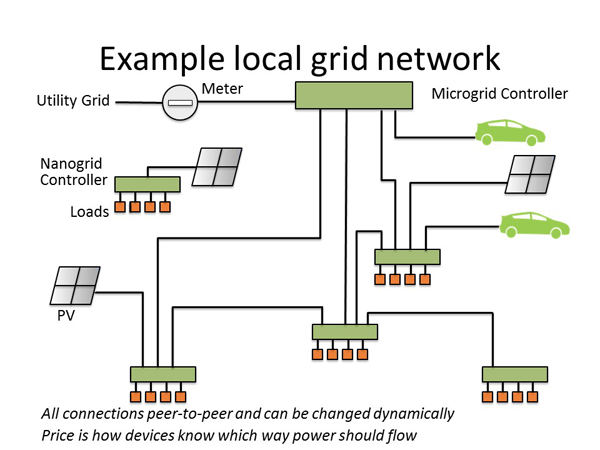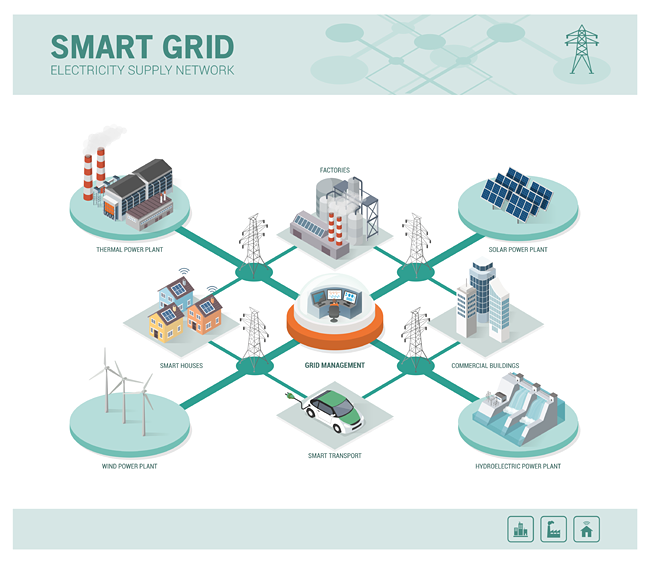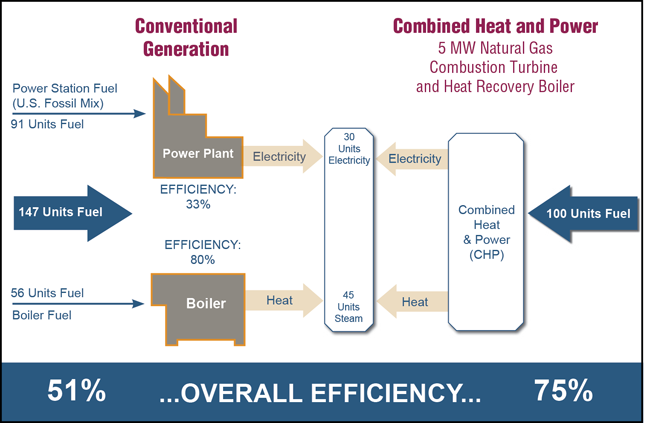Introduction
Within This Page
Much progress has been made on improving building energy efficiency over the past decades by focusing on the efficiency of individual building components (i.e., appliances and equipment) and, more recently, the efficiency of the building as a whole. As a middle ground between component and whole-building efficiency, a building systems approach considers the interactions of components within and among building systems, as well as interactions among multiple buildings, and between the building and the electric grid. Adopting a systems perspective will become increasingly necessary to achieve meaningful and cost-effective future energy savings within the built environment.
In addition to improving energy performance, a systems approach has the potential to achieve significant non-energy benefits: reduced carbon emissions (commercial buildings alone account for about 18 percentDownload 2011bedb.pdf of direct and indirect greenhouse gas emissions), improved grid reliabilityDownload TM2007-060.pdf , water savingsDownload ws-commercial-factsheet-offices.pdf , and extended equipment life and increased occupant comfort and productivityDownload CEC-500-2003-082-A-09.PDF . The quantifiable non-energy benefitsDownload BenefitsReport_Final_March20142.pdf have been estimated to range from 25 to 50 percent of the total benefits of energy efficiency across all sectors.
Description
Defining Systems Efficiency and its Role in Whole Building Design and Operation
A building system is a combination of equipment, operations, controls, accessories, and means of interconnection that use energy to perform a specific function. Examples include HVAC, water heating, lighting, thermal envelope, and miscellaneous electrical load systems.
- System energy efficiency is defined as the ratio of the services or functions provided by a building system to the amount of energy that system consumes, taking into account the thermal load imposed on (or thermal energy contributed to) other building systems.
- " To achieve a systems-efficient building, multiple systems (e.g., lighting, HVAC&R) must be designed, installed, and operated to optimize performance collectively with other energy systems both within and outside of the building to provide a high level of service for a given level of energy use.
Whole Building Design includes both an integrated design approach and an integrated team process. An integrated design approach ensures that the interrelationships and interdependencies with all building systems are understood, evaluated, appropriately applied, and coordinated concurrently from the planning and programming phase. Systems efficiency is one of the strategies used to implement Whole Building Design.
The Case for a Systems Approach
Improving the efficiency of building systems will support the WBDG objectives for sustainable, cost-effective, functional, and secure/safe, whole-building design and operation.
Energy Savings
(Optimize Energy Use for Sustainability Objective)Despite decades of improvement in equipment efficiency, the overall energy use of U.S. commercial buildings continues to increase. Energy intensity (energy/floor area) has been declining but not fast enough to offset floor space growth - due in part to the rapid increase in miscellaneous loads, which also create additional cooling loads. By 2035, miscellaneous end-uses are projected to use as much energyDownload 0383(2015).pdf as all other building end-uses combined. The combination of these new loads and growing floor space means that new approaches to efficiency will be needed to stem overall growth in building energy use. Optimizing performance at the systems and multi-systems level offers one promising path forward.
Examples of energy savings potential include:
A DOE study in 2011 identified a number of systems-level technologies, including solar-enhanced (desiccant) cooling, demand-controlled ventilation, and a dedicated outdoor air system to separately control latent and sensible cooling, individually had the potential to save between 0.1 and about 1.1 Quads/year of energy if applied to commercial buildings nationwide.
A 2012 meta-analysis of the literature on energy savingsDownload 0193-000071.pdf from lighting controls in commercial buildings looked at 240 studies, concluding that national savings from various strategies would be ". . . 24 percent for occupancy [controls], 28 percent for daylighting, 31 percent for personal tuning, 36 percent for institutional tuning, and 38 percent for combined approaches".
A 2013 study of a high-performance office building in New York City measured the impact of lighting controls (along with other measures) on three floors. Energy savings of 56 percentDownload lbnl-6023e.pdf resulted from daylight dimming controls and setpoint tuning in the daylighted spaces, compared to a code-compliant (ASHRAE 90.1-2001) building with scheduled on/off controls only.
Cost—Effective
Some mechanical equipment, light sources, and other building components are approaching technical and economic limitations for achieving further efficiency improvements. As these limits are approached, the costs of marginal efficiency improvements at the component level will rise. A systems approach offers creative avenues to further, cost-effective energy savings.
Support for Appropriate Product/Systems Integration
(For Functional/Operational Objective)
Highly efficient components do not necessarily result in an efficient building. Optimized building efficiency requires consideration of the interactions among components and with the building.
Secure and Safe
Emerging opportunities for attaining significant efficiency gains-such as through the integration of smart grid connectivity and related control technologies-are optimally applied at the system level. Buildings-to-grid integration can enhance grid reliability. Conversely, when a grid outage does occur, systems such as passive solar design, natural ventilation, daylighting, thermal storage, and on-site generation coupled with battery storageDownload solarstorage_synergies_report.pdf allow a building to remain functional and habitable for an extended period.

Microgrids can enhance systems efficiency by allowing for dynamic interactions among distributed energy resources, the utility grid, and loads. Credit: Nordman, B., Khandekar, A., Spears, M., & Pezzola, M. (2017). Lawrence Berkeley National Laboratory. A Simulation of Local Power Distribution Control Strategies, presented at Second International Conference on DC Microgrids, Nurnburg, Germany, 2017.
System Efficiency Applications
Several building systems can reduce energy consumption through improved controlsDownload PNNL-25985.pdf , thermal exchanges, and multi-systems integration. While these measures may be easier to apply to new construction and major renovations, the majority of savings potential lies in changes to existing buildings. Opportunities for systems solutions in existing buildings are often associated with control systems installation or upgrades, interior renovations to accommodate new tenants, and end-of-life replacement of HVAC and other mechanical systems. Following are some examples of system efficiency measures:Lighting and Daylighting Systems
Energy used for lighting represents about 10 percent of commercial building electricity use. As defined by NEMA, an optimal lighting system is "a collection of luminaires and related lighting equipment installed in an application to provide the right amount of light where and when needed, with consideration of human comfort, visibility, safety and security, the physical environment, and daylight integration." Although energy efficient lighting components are critical, effective lighting and daylighting system design and controls can add significant energy savings. A lighting controls study in two GSA federal office buildings with updated LED lighting resulted in measured savings of 32-33 percentDownload wireless_advanced_lighting_controls_retrofit_demo_final-508a.pdf of lighting energy.
HVAC&R Systems
Energy used for HVAC&R systems represents over 50 percent of commercial building electricity use. HVAC&R systems (space cooling, space heating, ventilation, and refrigeration) are by far the largest users of energy in commercial buildings. In order to Optimize Energy Use, designers must consider specifying efficient HVAC systems, including efficient water— or air—based distribution, variable—speed controls, demand—based ventilation and heat or enthalpy recovery. Many potential sources of low-level heat, such as heat rejected from HVAC or refrigeration systems or from telecom and server rooms, could be captured for beneficial use in pre-heating hot water systems or to condition outside ventilation air.
Hot Water Systems
Building designers should prioritize the design of hot water distribution systems (e.g., pipe layout and the location of the heating system relative to points of use) to minimize the total heat lost while serving the load.
Motor Systems
Shifting to a systems approach that considers additional factors such as drivetrains, inverters and electronic drive controls—as well as the choice of motor—driven system components (e.g., for pumps and air—handlers)–has the potential to substantially increase the efficiency of the total motor system.
Miscellaneous Electric Loads
Miscellaneous electric loads (MELs) together currently account for about 28 percent of primary energy in commercial buildings, and in some high-efficiency buildings, over 50 percent of the electric load. According to DOE,
"…the amount of energy savings from replacing an individual device often does not justify the replacement cost. As a result, there is a need for developing overarching technological solutions that can achieve crosscutting reductions in energy consumption at minimum cost. Instead of targeting individual MELs, R&D advancements require going up one level (to systems of MELs) or down one level (to common MELs components)".
Strategies to reduce MELs include:
- Energy reduction at the device level by improving device efficiency
- Enhanced control of an individual device to reduce standby power
- Integration of MEL device controls with system-level sensors and controls and with other building systems to optimize building operation
Multi-systems Integration
To maximize whole-building efficiency we must recognize that buildings are made up of multiple systems and optimize their integrated performance. Integrated systems provide the controls and feedback needed for buildings to operate at peak efficiency.
Direct Current (DC) Power
As a multi-systems strategy, direct current power distribution within a building can reduce energy demand as well as contribute to grid balancing, expanded control options, and improved safety and reliability. DC distribution can deliver systems-oriented energy savings for lighting, MELs, and many HVAC&R components by:
- Reducing alternating current-to-DC (AC/DC) conversion losses and AC/AC transformer losses, in both active and "standby" modes.
- Making it more feasible to replace AC-driven devices with "native-DC" devices for computers, telecommunications, and consumer electronics, as well as for lighting, control systems, and motors (especially those in variable-load applications).
- Enhancing the value of native-DC on-site photovoltaic generation and battery storage by avoiding conversion losses.

Emerging opportunities for attaining significant efficiency gains-such as through the integration of smart grid connectivity and related control technologies-are optimally applied at the system level.
A Building Integrated Photovoltaics (BIPV) System is one example of an opportunity for DC distribution. Implementation of a BIPV system in combination with energy storage has the potential to reduce a building's billed energy charges by 42%Download solarstorage_synergies_report.pdf – and DC distribution can provide further savings by avoiding multiple DC/AC/DC conversions.
Multi-building Systems: CHP and DES
Better integration of energy systems applies both within and outside the building boundary. Examples include Combined Heat and Power (CHP), District Energy Systems, and Buildings-to-Grid Integration.
Combined Heat and Power (CHP)
CHP systems have the potential not only to save energy and reduce building operating costs but also to enhance building operational resilience and grid reliability ("Valuing Resiliency: How Should We Measure Risk Reduction?"). In addition to the potential direct energy savings from CHP (such as doubling the useful energy products derived from fuel used, there are three categoriesDownload 11_133.pdf of CHP "resilience value":
- Continued operation during major (low-probability/high-consequence) events;
- Power reliability under routine conditions; and
- Improved power quality

Combined Heat and Power (CHP) systems have the potential not only to save energy and reduce building operating costs but also to enhance building operational resilience and grid reliability. Credit: US EPA, Combined Heat and Power Partnership.
District Energy Systems (DES)
District energy systems can often improve energy productivity and energy diversity while reducing GHG emissions. According to the UN Environment Program, DES can reduce heating and cooling energy in urban buildings by as much as 30-50 percent . District energy is intrinsically open to diverse fuel sources on the thermal side; when combined with CHP it can diversify the source of both electricity and heat. DES systems can also be readily incorporate ice storage tanks to offset peak demands or to make better use of surplus generation from intermittent wind and solar resources. For the estimated 290 district energy systems in the U.S. that do not currently use CHP, conversion to CHP represents a tremendous opportunity for efficiency improvement .
Related/Emerging Issues
Developing System Metrics
Current metrics and regulations typically address rated equipment efficiency or whole-building performance as designed, but most do not address actual performance of equipment or buildings as installed and operated - although recent initiatives on outcome-based performance pathways represent a promising new direction.
New systems-level metrics, standards and tools could support the improved performance of building systems through system design and commissioning, in ways that consider typical building load profiles, operating patterns and regional climate conditions.
Systems Strategies for Existing Buildings
With about 5.6 million commercial buildings as of 2012 with expected lifetimes of several decades, it is clearly important to develop system-oriented retrofit strategies for the existing building stock as well as new construction. In existing buildings, integrated system retrofits can be implemented through a variety of approaches. These include:
- Retro-commissioning
- Controls retrofits to existing systems
- Building renovation
- Deep retrofits or sequenced planned retrofits
Systems Solutions for Smaller Buildings
As with the existing building stock, smaller commercial and residential buildings pose a special challenge to systems efficiency. Efficient systems solutions often require detailed energy modeling and design analyses, which are seldom cost-effective for smaller buildings. Thus, new approaches such as "packaged" system solutions need to be developed.
Reliability and Resiliency
As discussed above, efficiency gains in systems within the building (HVAC &R, lighting, MELs, etc.) and those outside the building such as CHP and DES all represent opportunities to reduce stress on the utility grid during peak demand periods and in case of unforeseen generation, transmission, or distribution outages, thereby enhancing the grid's reliability and resiliency. Emerging opportunities for Building-to-Grid (B2G) Integration offer the prospect of improved operational savings and reliability on both sides of the meter.
The evolution of a fully integrated, transaction-basedDownload ValuationTransactiveFinalReportPNNL25323.pdf building-grid and ecosystem will create new opportunities for optimizing system efficiencies, reliability and cost-effectiveness at both the building and grid scale, while paving the way for more effective integration of renewable resources and electric vehicles.
DOE's Grid Modernization Laboratory Consortium (GMLC) is working towards creating a next-generation grid operating system using grid-level integration of Energy Management Systems (EMS), Distribution Management Systems (DMS), and Building Management Systems (BMS), resulting in operations with less reserve margin and dramatically enhancing the energy and economic efficiency of the system. Systems integration and improved control systems (for example, GMLC's "Multi-scale Integration of Control Systems" also can lead to building improvements that have many other associated energy and non-energy benefits, including improved comfort, lower cost, and better integration of microgrids and distributed energy resources (e.g., solar PV, wind energy).
Relevant Codes, Standards, and Guidelines
- ANSI/ASHRAE/IES/USGBC Standard 189.1-2014, Standard for the Design of High-Performance Green Buildings
- ANSI C137.1, Lighting Systems
- Energy Star, certification for your building
- LEED Building Certifications
- LEED BD+C: Core and Shell Development — Green Building Council. This certification program provides incentives for systems efficiency as follows:
Additional Resources
Tools, Policies, and Ongoing Research that Support, Systems Efficiency
- Army Net Zero Initiative – U.S. Department of Defense. This initiative is a strategy for managing existing energy, water, and solid waste programs with the goal of exceeding minimum targets, where fiscally responsible, to provide greater energy and water security and increase operating flexibility.
- Energy Performance of Buildings Directive – EU of the European Parliament and of the Council. European legislation covering the reduction of the energy consumption of buildings.
- Implementing an Outcome-Based Compliance Path in Energy Codes: Guidance for CitiesDownload OBP-CityLevelGuide.pdf – National Institute of Building Sciences and New Building Institute. This report can be found on the Whole Building Design Guide's webpage titled Outcome-based Pathways for Achieving Energy Performance Goals.
- MotorMaster+ – U.S. Department of Energy. MotorMaster+ enables industrial energy coordinators, facility managers, and plant electricians to manage their motor inventory and maintenance logs in order to evaluate their energy efficiency and discover new ways to reduce energy use, thereby cutting costs and eliminating environmental impact.
- Performance Excellence in Electricity Renewal (PEER) – Green Business Certification Inc. This rating system for utility system energy efficiency and environment includes an incentive for Systems Energy Efficiency.
- S. 1874, Distributed Energy Demonstration Act of 2017 – Bill introduced by Senator Wyden.
- S. 1875, Flexible Grid Infrastructure Act of 2017 – Bill introduced by Senator Wyden.
- S. 1876, Reducing the Cost of Energy Storage Act of 2017. – Bill introduced by Senator Wyden.
- Savings by Design – California Utilities and Public Utilities Commission. This program offers incentives for building owners and design teams to take a systems efficiency approach.
- Smart Readiness Indicator for Buildings – VITO NV. This study provides technical support to the Directorate-General for Energy of the European Commission regarding potentially setting up a 'Smart Readiness Indicator (SRI) for Buildings'. SRI would give recognition for smarter building technologies and functionalities which enhance the energy efficiency and other pertinent performance characteristics of the building stock.
- Systems Program Manuals and Assessment Methods – Lawrence Berkeley National Laboratory. These program manuals allow the user to go "beyond widgets" by taking a systems level approach to realize deeper energy savings.
- VOLTTRON Controller for Integrated Energy Systems to Enable Economic Dispatch Improve Energy Efficiency and Grid Reliability – Grid Modernization Laboratory Consortium. This project will design, develop, field test, and commercialize a multi-purpose controller and associated open-source algorithms that will ensure real-time optimal operation, increase electric grid reliability, and lead to the goal of clean, efficient, reliable and affordable next generation integrated energy system (IES).
References
- 2012 Commercial Buildings Energy Consumption Survey: Energy Usage Summary, Table 5., U.S. Energy Information Administration (EIA), 2012
- Annual Energy OutlookDownload 0383(2015).pdf, U.S. Department of Energy (U.S. DOE), 2015
- ANSI C137 Lighting Systems Committee, National Electrical Manufacturer Association (NEMA)
- Building Energy Codes Program: National Benefits Assessment, 1992-2040Download BenefitsReport_Final_March20142.pdf, by Livingston, O.V., P.C. Cole, D.B. Elliot, and R. Bartlett. Rep. no. PNNL-22610 Rev 1. Prepared for the U.S. Department of Energy. Oak Ridge, TN: Pacific Northwest National Laboratory, 2014
- Buildings Energy Efficiency Frontiers & Innovation Technologies (BENEFIT)-2017 Funding Opportunity Announcement (FOA) Number: DE-FOA-0001632, by the U.S. Department of Energy (U.S. DOE) 2016
- District Energy in Cities-Unlocking the Potential of Energy Efficiency and Renewable EnergyDownload DES_District_Energy_Report_full_02_d.pdf, by the UN Environment Program (UNEP), ND
- Enhancing Community Resilience through Energy Efficiency, by Ribeiro, D., Mackres, E., Baatz, B., Cluett, R., Jarrett, M., Kelly, M., and Vaidyanathan, S.. ACEEE, October 2015
- Energy Savings Potential and Research, Development, and Demonstration Opportunities for Commercial Building Heating, Ventilation, and Air Conditioning Systems: Final Report. Navigant report for DOE, by Goetzler, W., R. Zogg, H. Hiraiwa, J. Burgos, and J. Young. 2011
- Green Buildings Matter, by Moore, Michelle. The American Prospect, 17 December 2006.
- Impacts of Commercial Building Controls on Energy Savings and Peak Load ReductionDownload PNNL-25985.pdf, by Pacific Northwest National Laboratory, May 2017
- Loads Providing Ancillary Services: Review of International ExperienceDownload TM2007-060.pdf, by Heffner, G., C. Goldman, B. Kirby, and M. Kintner-Meyer. May 2007
- Miscellaneous Energy Loads in Buildings ACEEE Rep. no. A133, by Kwatra, S., J. Amann, and H. Sachs. [ OnlineDownload a133] 27 June 2013
- Reducing Plug and Process Loads for a Large Scale, Low Energy Office Building: NREL's Research Support FacilityDownload 49002.pdf, By "Lobato, C., S. Pless, M. Sheppy, and P. Torcellini. 2011 (b). NREL/CP-5500-49002. Oak Ridge, TN.
- A Post-Occupancy Monitored Evaluation of the Dimmable Lighting, Automated Shading, and Underfloor Air Distribution System in The New York Times BuildingDownload lbnl-6023e.pdf, by Lee, E.S., L.L. Fernandes, B. Coffey, A. McNeil, R. Clear, T. Webster, F. Bauman, D. Dickerhoff, D. Heinzerling, and T. Hoyt. LBNL-6023E. January 2013
- Quantifying National Energy Savings Potential of Lighting Controls in Commercial BuildingsDownload 0193-000071.pdf, by Williams, A., B. Atkinson, K. Garbesi, and F. Rubinstein. ACEEE, 2012
- Recognizing the Value of Energy Efficiency's Multiple Benefits. Research Report IE1502, by Russell, C., B. Baatz, R. Cluett, and J. Amann. American Council for an Energy-Efficient Economy, 2015
- Saving Water in Office BuildingsDownload ws-commercial-factsheet-offices.pdf, by the U.S. Environmental Protection Agency (EPA), January 2017
- Smart Tools in a 111d Toolbox: Combined Heat and Power and District EnergyDownload 111dToolbox-v10.pdf, by the International District Energy Association (IDEA). N.D.
- Solar + Storage Synergies for Managing Commercial-Customer Demand Charges, Slide #13Download solarstorage_synergies_report.pdf, by Gagnon, P. et al. 2017
- The U.S. Appliance Standards Program (a)Download 2015_BTOpr_Plenary_Standards.pdf, by the U.S. Department of Energy (U.S. DOE), April 2015
- Valuation of Transactive SystemDownload ValuationTransactiveFinalReportPNNL25323.pdf, by Pacific Northwest National Laboratory, May 2016
- Valuing Resiliency: How Should We Measure Risk Reduction? Proceedings of the 2016 ACEEE Summer Study on Energy Efficiency in BuildingsDownload 11_133.pdf, by Chittum, A. Asilomar, CA: August 2016
- Windows and Offices: A study of worker performance and the indoor environmentDownload CEC-500-2003-082-A-09.PDF, Prepared by Heschong Mahone Group Inc. California Energy Commission, 2003
- Wireless Advanced Lighting Controls Retrofit DemonstrationDownload wireless_advanced_lighting_controls_retrofit_demo_final-508a.pdf, by Wei, J., F. Rubinstein, J. Shackelford, and A. Robinson. Lawrence Berkeley National Laboratory. Rep. no. LBNL-183791, April 2015










